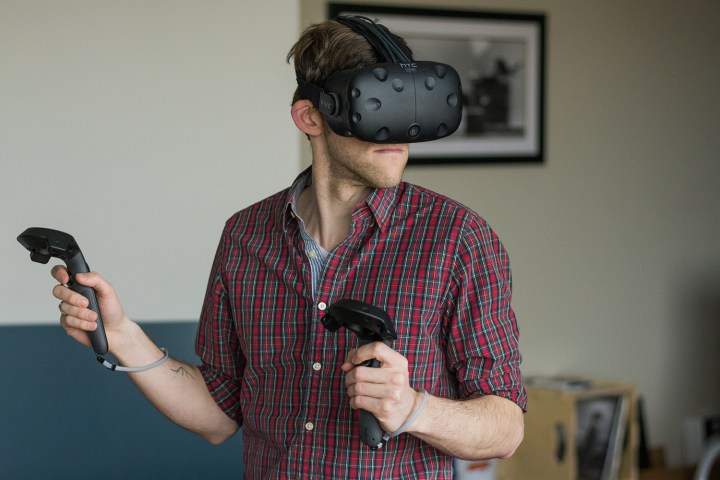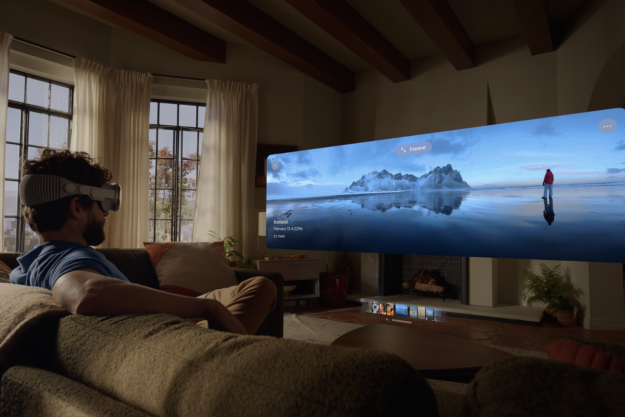
How it will be received, however, remains a point of contention. For every superfan counting down the days until a headset arrives, there’s a skeptic worried it’s too expensive to be justified, too complex, and won’t be fun for all but the most enthusiastic.
Valve’s instructions are straightforward, and the hardware is way more forgiving than you’d think.
Those are good points; I’ve raised them in the past. A $400 to $800 price tag is insane for a peripheral. Add-on devices sold for more than $50 have a history of failure. Just look at PC joysticks. A few high-end models exist for real sim-game nuts, but the most popular model is $30.
What this doesn’t account for, though, is the wild card of experience. Ken Olson, president of Digital Equipment Corporation, said in 1977 that “there is no reason for any individual to have a computer in his home.” That statement may seem daft now, but at the time it seemed reasonable. Why, after all, would a home user spend thousands for a device that seemed little more than a glorified typewriter?
Related Offer: PlayStation VR at Gamestop | Playstation VR at Best Buy
Olson didn’t account for the PC growing into a hugely capable device, unlike anything an individual could ever own before. Sometimes, perhaps once a decade, an incredible new technology appears. Often, it is expensive. But the totally unique experience it offers overcomes that obstacle. Virtual reality – and specifically, the HTC Vive – is such a technology.
Easier than you think
VR has been available, in rudimentary form, for several years already. You could buy an Oculus Rift development kit as early as 2012. That headset’s long-term beta helped prepare the technology for everyday users, but has also shrouded it in an aura of technical mystery. VR looks like a gadget for skilled geeks, not something anyone can use.
The Vive proved that notion wrong within minutes. Sure, it comes with a snarl of cords, but Valve’s instructions are straightforward, and the hardware is way more forgiving than you’d think. The worrisome “lighthouse” sensors, for example, are forgiving.
Don’t have much room? The Vive can work as a standing-only headset, or a sit-down experience, if you’d like. Is your room a strange shape? That can be handled, too. Do you have a few friends who want to gawk at you while you’re in a virtual world? No problem. A small crowd can gather around the user before the lighthouses start to lose track of her.
Launching content is also simple, accomplished through an intuitive VR interface that’s a lot like Steam’s Big Picture Mode, but better. Games don’t require additional setup.
You can weave through gunfire by dropping to the floor, then rocket back to your feet with guns blazing.
Admittedly, the Vive isn’t entirely glitch-free. I ran into a pairing issue after updating the Vive’s firmware. It was cleared up by restarting SteamVR, which takes just a few seconds. And one of the controller touchpads had trouble for several minutes in Google Tilt Brush, an app for making VR art that comes free with the headset. Again, restarting the app fixed it.
So some effort is required. But it’s nowhere near as technical as expected, and setup can be accomplished within 15 minutes by anyone who doesn’t feel frustrated the moment they sit down in front of a PC.
That bodes well for the Rift, too. I haven’t had the chance to try it in a real-world setting, but in theory its setup should be a lot less complex. If the Vive is intuitive, the Rift should be a cinch.
You’ve never used anything like this
Removing the technical barrier separating users from virtual reality is a big step, but jumping that hurdle needs to land them close to an experience they want to use. Virtual reality is not going to launch with a killer app. There’s no Witcher 3 or Fallout 4 designed for the Rift or Vive. The Vive does, however, have a number of mini-games that prove virtual reality is more than a fad.
Space Pirate Trainer is a basic but effective showcase of how VR can turn formerly boring concepts into great fun. It’s a simple wave-based shooting gallery, where the goal is to slay as many robots as possible before dying. On a console or PC it would be a snooze, but the Vive adds a new dimension. You can dodge bullets (thanks to an automatic bullet-time feature) in real space, and use a shield, which is drawn on or off your back like pulling an arrow from a quiver, to block attacks. Even staffers who’d never used VR before were thrilled, weaving through gunfire by dropping to the floor, then rocketing back to their feet with guns blazing. This will no doubt become a popular genre. Add more enemy types, more guns, some level variety — this could be an awesome game.

Another winner is Fantastic Contraption, a game about building vehicles that transport a glowing pink orb back home. Physics-based puzzlers are a popular genre already and take on a new dimension in VR. Rather than looking down on your creation, you’re beside it, in it, building as if it’s in your garage. This interaction adds a new dimension to puzzlers, with many promising directions the genre could go. Imagine a bridge-building game from a first-person perspective, or a god-game where you tower over your creation and mold it with your hands.
A wide variety of seated experiences and ports of non-VR titles should help fills the early gaps. Games like Project Cars, Elite Dangerous, and American Truck Simulator will support the Rift, the Vive, or both. These experiences may not be made for VR exclusively, but they should help keep you entertained until games tooled specifically for VR become more common.
The future is here
Our time with the Vive has proven to us that VR will be the next big thing.
Yes, it’s expensive. It requires a costly headset, and in most cases also demands a powerful PC. This will put it out of reach of many people, to begin with. That’s the only obstacle. VR is easy to set up, and awesome to experience.
There will be growing pains, as with any technology. PCs didn’t become common until a decade after they first appeared, and smartphones took half a decade to truly dominate.
But they were inevitable, for a simple reason – they gave people something amazing, and useful, which they couldn’t have before. VR does that, too. It’s the future, and the Vive proves it.
Editors' Recommendations
- This new VR headset beats the Vision Pro in one key way and is half the price
- You really do not want to forget your Vision Pro passcode
- Watch Apple’s new ‘Get Ready’ ad for its Vision Pro headset
- HTC just fixed a major shortcoming of standalone VR headsets
- The Vision Pro SDK has arrived. Here’s what it’s revealed so far


